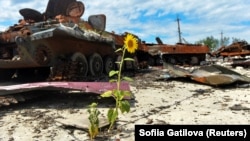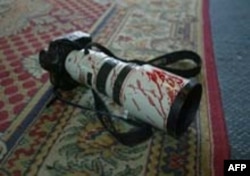More than five months since Russia invaded Ukraine, a war of attrition has emerged with losses of materiel and men on both sides, not advances on the ground, becoming the key barometer of the conflict, a leading U.S.-based expert on Russia’s military has told RFE/RL’s Georgian Service.
Those casualties and equipment losses will largely determine the “long-term sustainability of the war efforts” by Russian and Ukrainian forces, explained Michael Kofman, who heads the Russia Studies Program at the Virginia-based think tank CNA.
Live Briefing: Russia's Invasion Of Ukraine
RFE/RL's Ukraine Live Briefing gives you the latest developments on Russia's invasion, Western military aid, the plight of civilians, and territorial control maps. For all of RFE/RL's coverage of the war, click here.
The conflict is now “defined much more by heavy use of artillery and firepower,” Kofman said, with neither side “able to gain momentum.”
Since April, the Kremlin has concentrated on capturing the Donbas, an industrial region of eastern Ukraine where Russia-backed separatists are in control. “Where Russian forces have advanced those advances have been incremental, Ukrainian forces have been able to conduct tactical withdrawals pretty consistently,” Kofman said.
His comments come as an assessment by the Canadian Forces Intelligence Command on July 22 said that “due to significant losses of personnel and equipment, Russia probably no longer has the military capacity to realize its ambitions in Ukraine.”
Richard Moore, chief of the British Secret Intelligence Service known as MI6, said on July 21 that Moscow’s forces would likely start an operational pause of some kind in Ukraine soon, adding that the Russian military would increasingly find it difficult to supply manpower and materiel over the next few weeks.
Despite those assessments, Russian Foreign Minister Sergei Lavrov said on July 20 that Russia's ambitions in Ukraine now went far beyond the eastern Donbas region to include a swath of land in the south and "a number of other territories."
Lavrov claimed that Russia’s new territorial ambitions were driven by the course of the war. But in the early stages of the invasion, Russia tried to occupy much of Ukraine’s south and capture the capital, Kyiv.
Ukrainian authorities have claimed that Russia has lost -- as of July 23 -- more than 39,240 soldiers and officers since it launched its large-scale invasion of Ukraine on February 24. The Russian Defense Ministry last released casualty figures in late March, saying that 1,351 of its personnel had died.
To beef up depleted forces, Russia is using the private military contractor Vagner, British military intelligence said on July 18.
The British Defense Ministry said Vagner is lowering its recruitment standards and hiring convicts and formerly blacklisted individuals, potentially impacting Russian military effectiveness.
Along with Vagner contractors, the Russian military is relying more on volunteer and reserve battalions because of a shortage of infantry, Kofman explained, and that those troops are now fighting more and more with less lethal Soviet-era equipment, such as “older T-80BV tanks.”
“Russia still has quite a bit of equipment in storage. That's true. But it's a considerable step down in terms of quality and technological level compared to what they began the war with. The attrition issue is significant. I think it's fair to say that, in key categories, they've lost 30 percent of the active armored force,” Kofman said.
Military casualties are also a “challenge” for Ukraine, Kofman noted.
“It's not the same challenge. But nonetheless, there is a similar long-term challenge for Ukraine to avoid force degradation, because it's clear that as the war has gone on Ukraine has also lost a number of its best units that [they] are forced to replace with mobilized personnel and individuals who have limited basic training,” he explained.
Ukrainian President Volodymyr Zelenskiy told The Wall Street Journal in a July 22 interview that Ukraine’s military was losing between 100 and 200 servicemen per day in May and June, but that those numbers have now dropped to 30 dead and some 250 wounded daily.
Western Weapons
Zelenskiy said Western weapons, especially longer-range missiles such as U.S. HIMARS -- high-mobility artillery rocket systems -- which Ukraine has deployed in recent weeks, had helped to stabilize the situation in the Donbas.
“I think that HIMARS certainly is going to help Ukraine gain a degree of parity with Russian artillery, and is going to create a big problem for the Russian military, and how they organize both logistics and command and control and the degree of attrition they take on the battlefield,” predicted Kofman.
HIMARS have a longer range and are more precise than the Soviet-era artillery that Ukraine had in its arsenal, and Ukrainian officials have said their deployment has been critical in the fight to repel Russian troops and to strike their supply lines.
U.S. Defense Secretary Lloyd Austin announced on July 20 the United States would send four more HIMARS to Ukraine, a day after such a request was made by Ukrainian Defense Minister Oleksiy Reznikov, who said Kyiv's forces had used them to destroy some 30 Russian command stations and ammunition depots.
The four additional HIMARS will bring to 16 the number sent by the United States. Austin said the new package would also include ammunition for multiple-launch rocket systems (MLRS) that can precisely strike targets that are scores of kilometers away.
"I think the challenge for the Russian military will be if Ukraine increasingly makes use of operational level strike capabilities like HIMARs to target Russian ammunition dumps, where whether Russia has large supplies of ammo or not will no longer matter, because it won't be able to effectively get them to the battlefield, because they keep getting destroyed over time and thus it proves hard for the Russian military to then concentrate them," Kofman explained.
Russia's options to counter the HIMARS are minimal, he added.
The truck-mounted HIMARS launchers fire GPS-guided missiles capable of hitting targets up to 80 kilometers away, a distance that puts them out of reach of most Russian artillery systems.
"That's one of the biggest challenges for them, because their ability to obtain air superiority is at best localized, and their counterstrike options are limited. So, their capacity for targeting HIMARS isn’t particularly good."




